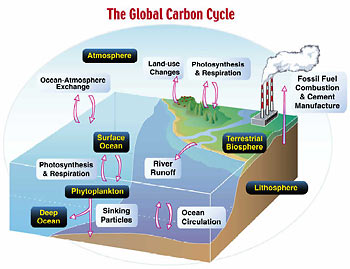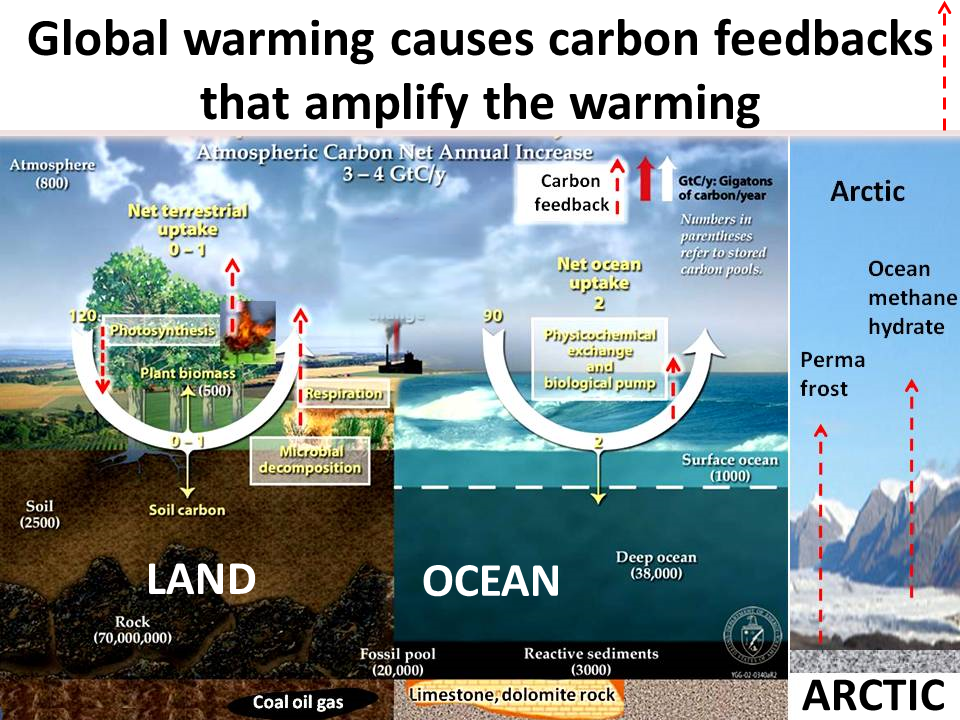Climate Change - Hotter or colder?
The energy that affects the climate on the Earth originates from the Sun.
The energy emitted by the Sun passes through space, until it hits the Earth’s atmosphere.
Only about 40% of the solar energy hitting the top of the atmosphere passes through to the Earth’s surface.
The rest is reflected, or absorbed by the atmosphere.

Here are some of the many factors that can cause the Earth's climate to get hotter or colder.
These factors are sometimes referred to as 'forcings'.
Strength of the sun
The energy output of the sun is not constant, it varies over time.
Recently it has been reducing slightly.

The next two factors are astronomical cycles.
Changes in the Earth’s orbit
The Earth’s orbit around the Sun is an ellipse, not a circle, but the ellipse changes shape.
Sometimes it is almost circular - and the Earth stays approximately the same distance from the Sun as it orbits.
At other times the ellipse is more stretched, so that the Earth moves closer and further away from the sun as it orbits.
When the Earth is closer to the sun our climate is warmer.


Changes in the angle of the Earth’s axis of rotation
 The Earth rotates around an axis (imagine a line that joins the north and south poles) but the Earth’s axis is not upright, it leans at an angle.
This angle changes with time.
Over about 41 000 years it moves from 22.1 degrees to 24.5 degrees and back again.
When the angle increases, the summers become warmer and the winters become colder.
Quantity of greenhouse gases in the atmosphere
The Earth rotates around an axis (imagine a line that joins the north and south poles) but the Earth’s axis is not upright, it leans at an angle.
This angle changes with time.
Over about 41 000 years it moves from 22.1 degrees to 24.5 degrees and back again.
When the angle increases, the summers become warmer and the winters become colder.
Quantity of greenhouse gases in the atmosphere

These include carbon dioxide, methane and water vapour.
 Of these, water vapour makes the greatest contribution to the greenhouse effect because there is more of it.
However, if one of those gases increases or decreases more than the others, it will be that gas that begins to affect the global temperature.
Of these, water vapour makes the greatest contribution to the greenhouse effect because there is more of it.
However, if one of those gases increases or decreases more than the others, it will be that gas that begins to affect the global temperature.

Carbon dioxide content of the oceans
The oceans contain more carbon dioxide (CO2) than the atmosphere and they can also absorb CO2 from the atmosphere.
When the CO2 is in the oceans it does not trap heat as it does when it is in the atmosphere.
 Plate tectonics
Plate tectonics

Over time, plate tectonic processes cause continents to move to different positions on the globe.
For example, Britain was near to the equator 300 million years ago, and therefore was hotter than it is today.
The movement of the plates also causes volcanoes and mountains to form and these too can contribute to a change in climate.
Ocean currents
Ocean currents carry heat around the Earth.
The direction of these currents can shift so that different areas become warmer and cooler.
Oceans store a large amount of heat, so that small changes in ocean currents can have a large effect on coastal and global climate.
Vegetation coverage on the land
On a global scale, patterns of vegetation and climate are closely correlated.
Vegetation absorbs carbon dioxide and this can buffer some of the effects of global warming.


Sum of the parts
Each of the above factors contribute to changes in the Earth’s climate, however the way they interact with each other makes it more complicated.
A change in any one of these can lead to additional and enhanced changes in the others.
For example, we understand that the oceans can take carbon dioxide out of the atmosphere:
When the quantity of CO2 in the atmosphere increases, the temperature of the Earth rises.
This in turn would contribute to a warming of the oceans.
Warm oceans are less able to absorb CO2 than cold ones, so as the temperature rises, the oceans release more CO2 into the atmosphere, which in turn causes the temperature to rise again.

Each of the above factors contribute to changes in the Earth’s climate, however the way they interact with each other makes it more complicated.
A change in any one of these can lead to additional and enhanced changes in the others.
For example, we understand that the oceans can take carbon dioxide out of the atmosphere:
When the quantity of CO2 in the atmosphere increases, the temperature of the Earth rises.
This in turn would contribute to a warming of the oceans.
Warm oceans are less able to absorb CO2 than cold ones, so as the temperature rises, the oceans release more CO2 into the atmosphere, which in turn causes the temperature to rise again.
Warm oceans are less able to absorb CO2 than cold ones, so as the temperature rises, the oceans release more CO2 into the atmosphere, which in turn causes the temperature to rise again.



